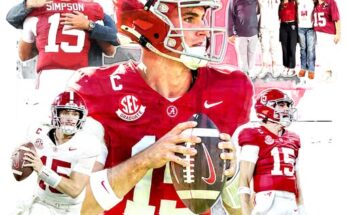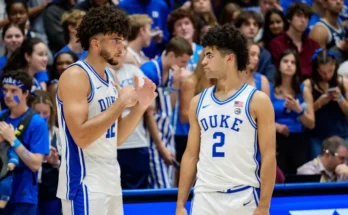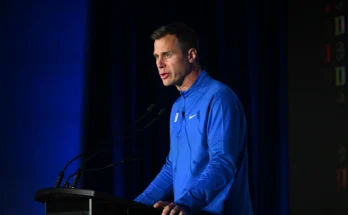Lamar Jackson of the Baltimore Ravens and Dale Earnhardt Jr. settle their trademark dispute.
In a high-profile legal battle that had the potential to affect the branding efforts of two sports icons, Lamar Jackson, quarterback for the Baltimore Ravens, and Dale Earnhardt Jr., the legendary NASCAR driver, have come to an agreement, settling their trademark dispute. The resolution not only marks a key moment in the personal branding of both athletes, but it also underscores the growing importance of intellectual property rights within the sports industry. This article explores the details of the dispute, the legal arguments made by both sides, and the implications of the settlement for the future of sports branding.
The Origin of the Dispute
The story behind the dispute dates back to Lamar Jackson’s filing for a trademark in 2021 for the phrase “You Got to Be a Savage.” Jackson had become increasingly active in promoting merchandise that reflected his bold and competitive persona on the field. The phrase “You Got to Be a Savage,” which he frequently used in interviews and public appearances, was seen as a reflection of his mentality as a fierce and relentless player.
However, this trademark filing soon ran into trouble. Dale Earnhardt Jr., a prominent figure in NASCAR and an established brand in the world of motorsports, had been using the phrase “You Got to Be a Savage” for years as part of his own brand. The phrase was deeply associated with Earnhardt’s public persona, and he had been using it as part of his merchandise, especially in relation to his racing apparel and media ventures.
Upon learning of Jackson’s trademark application, Earnhardt Jr. and his team quickly filed an opposition with the U.S. Patent and Trademark Office (USPTO). They argued that the phrase “You Got to Be a Savage” was already strongly associated with Earnhardt Jr.’s brand and that Jackson’s use of the phrase could confuse consumers, potentially damaging the value of Earnhardt’s established trademark.
Trademark Law and the Role of the USPTO
The dispute between Jackson and Earnhardt Jr. centered on trademark law, specifically the concept of “likelihood of confusion.” In intellectual property law, trademarks serve to distinguish the goods or services of one entity from those of another. If two entities use the same or similar trademarks for related goods or services, it could cause consumer confusion, which is the primary concern of trademark law.
In this case, the USPTO evaluates whether the phrase “You Got to Be a Savage” was distinctive enough to be trademarked by Jackson, and whether the public might confuse the phrase with Earnhardt’s pre-existing brand. Trademark law requires that a proposed mark must not conflict with an existing mark that is likely to confuse consumers or dilute its distinctiveness.
Both Jackson and Earnhardt’s teams presented strong legal arguments. Jackson’s team emphasized that he had popularized the phrase in his own right, particularly in the context of his on-field performances. They argued that Jackson’s brand was distinct from Earnhardt Jr.’s, focusing on football rather than racing. However, Earnhardt Jr.’s legal team pointed to the long-standing association between the phrase and his brand, arguing that Jackson’s use of the phrase in a different sport didn’t necessarily eliminate the risk of consumer confusion.
The legal battle was shaping up to be a lengthy and contentious affair, as both sides seemed determined to protect their brands and intellectual property. The dispute raised important questions about the intersection of sports and trademark law and how similar phrases can be legally contested in an era of celebrity-driven branding.
The Settlement
After several months of legal wrangling, the dispute between Jackson and Earnhardt Jr. was resolved through a settlement. The terms of the settlement were not immediately disclosed to the public, but sources close to the case revealed that both parties reached a mutually agreeable resolution.
Reports indicated that Jackson would be granted the right to use the phrase “You Got to Be a Savage” in connection with his brand, including on merchandise such as T-shirts and other fan gear. However, the details of how the phrase would be used—whether there were any modifications to the specific use of the phrase or if there were any restrictions placed on its use in connection with certain products—were not made public.
In return, Earnhardt Jr. would retain the rights to the phrase as it relates to his own brand, which includes his racing merchandise and media ventures. The settlement also suggested that both parties agreed to avoid further legal action and to move forward with their respective brand-building efforts without further interference from one another.
The outcome of the settlement was seen as a win for both Jackson and Earnhardt Jr. Jackson was able to protect his burgeoning merchandise line, while Earnhardt Jr. was able to safeguard his long-established brand without having to engage in protracted litigation. By avoiding a lengthy trial, both athletes preserved their public images and reputations, which is critical in the highly competitive world of personal branding.
The Impact on Branding and Intellectual Property in Sports
The settlement between Jackson and Earnhardt Jr. highlights the growing importance of intellectual property in the sports world. As athletes continue to build their brands beyond the playing field, trademarks and logos have become central to their identities. For Jackson, his brand is more than just his football career—it extends to merchandise, endorsements, and the way he presents himself to the public. The same holds true for Earnhardt Jr., whose brand is synonymous with NASCAR and motorsport culture.
As athletes become increasingly involved in business ventures, their names, logos, and catchphrases have become valuable commodities. The Lamar Jackson-Dale Earnhardt Jr. dispute is part of a larger trend in which athletes and entertainers must navigate the complex world of intellectual property law to protect their personal brands. The case also highlights the difficulties that arise when two high-profile individuals have overlapping markets or product categories.
For fans, this case serves as a reminder that even phrases or slogans that seem to be part of everyday language can have significant legal implications when they are associated with powerful brands. In today’s world, where athletes and celebrities are often their own brands, intellectual property disputes like this one are likely to become more common.
Lessons Learned from the Dispute
The Lamar Jackson-Dale Earnhardt Jr. trademark dispute offers valuable lessons for athletes, celebrities, and entrepreneurs alike. First, it highlights the importance of conducting thorough trademark searches before attempting to register a phrase or logo. In this case, Jackson’s team may have been unaware of Earnhardt Jr.’s prior use of the phrase, which ultimately led to the conflict. A more diligent search could have avoided this legal battle entirely.
Second, the case underscores the need for athletes to be proactive in protecting their intellectual property. As more athletes look to expand their personal brands and capitalize on merchandise sales, understanding the intricacies of trademark law becomes increasingly crucial. In some cases, it may be necessary to work with legal experts to ensure that trademarks are properly registered and defended against potential infringement.
Lastly, the dispute illustrates the benefits of reaching a settlement instead of engaging in a lengthy and public legal battle. Both Jackson and Earnhardt Jr. were able to preserve their brands and reputations by avoiding a drawn-out trial. This approach allowed them to move forward with their respective careers and avoid the negative publicity that often accompanies high-profile legal cases.
Conclusion
The settlement between Lamar Jackson and Dale Earnhardt Jr. marks the end of a legal dispute that could have had far-reaching implications for their personal brands. While both athletes came away from the dispute with their respective trademarks intact, the case serves as a cautionary tale for others navigating the complex world of intellectual property in the sports and entertainment industries.
In the end, the resolution of the case highlights the growing role of trademarks in shaping the public personas of athletes and the increasing need for athletes to be aware of the legal and financial aspects of their brands. With the rise of athlete-driven merchandise and endorsements, this case will likely set a precedent for future trademark disputes in the world of sports.
As Lamar Jackson continues to carve out his legacy on the football field and Dale Earnhardt Jr. maintains his influence in the world of motorsports, both athletes will continue to be at the forefront of the evolving landscape of personal branding in sports. The resolution of this trademark dispute demonstrates the importance of protecting one’s brand in an era where identity is more than just a name—it’s a valuable asset.



